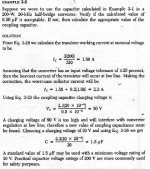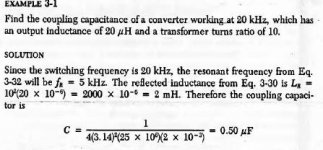luka,
all of the parts came from old radio transmitters or some other local hams ( amateur radio operators). i was able to talk the boss at a local company who makes air conditioners for the sheet metal and use of their machine shop to make the panels, the meters and thumbscrews came from a surplus vehicle battery charger, the wire is umhw #8 or #10, the fans are from pc supplies, a 12v wall wart powers them through an old household mercury thermostat.
the panel on the right is just 2 sets of voltmeters and ammeters with current sensors for the supply and load for my batteries to power my radio room and mircowave when we lose power. we live in rural nebraska, snow, wind, cold, tornados, corn...............
all told the cost is probably less than 50 dollars.
i know a lot more about older stlye switching supplies with tubes, thyratrons at a lower frequency and way more power than these, so this is interesting.
by the way tell me about the calculations i made? am i wrong and why.....
thanks
all of the parts came from old radio transmitters or some other local hams ( amateur radio operators). i was able to talk the boss at a local company who makes air conditioners for the sheet metal and use of their machine shop to make the panels, the meters and thumbscrews came from a surplus vehicle battery charger, the wire is umhw #8 or #10, the fans are from pc supplies, a 12v wall wart powers them through an old household mercury thermostat.
the panel on the right is just 2 sets of voltmeters and ammeters with current sensors for the supply and load for my batteries to power my radio room and mircowave when we lose power. we live in rural nebraska, snow, wind, cold, tornados, corn...............
all told the cost is probably less than 50 dollars.
i know a lot more about older stlye switching supplies with tubes, thyratrons at a lower frequency and way more power than these, so this is interesting.
by the way tell me about the calculations i made? am i wrong and why.....
thanks
I'm afraid I can't help you with calc., coz I don't know if they are right or wrong.I don't have almost any spec for my cores, so I go by the ear...
dc blocking cap
so...
what would be a good way to determine the size for the cap in series with the main transformer?
to handle the current?
i have 4, 0.1 @ 600V non polorized in parallel...
so...
what would be a good way to determine the size for the cap in series with the main transformer?
to handle the current?
i have 4, 0.1 @ 600V non polorized in parallel...
One note:
When you do your transformer equation with a switch mode converter....
You need to account for the Duty-Cycle..... or worst case largest Duty Cycle... Volt-Seconds.....
The 4 you have in the denominator is for continous Square wave, assuming 50% Duty Cycle....
I have done a bit of High Power switchers.... last one was 32V at 40 Amps.... The circuit was no bigger than 6"x4" and .5" tall.....
That did not include the caps......
It was a Quasi Resonant mode switcher that put out very low EMI....
The output current limit was clamped at 42 Amps......
You could put your hand on the circuit, never really got to warm...
Switching at 500kHz...
Chris
When you do your transformer equation with a switch mode converter....
You need to account for the Duty-Cycle..... or worst case largest Duty Cycle... Volt-Seconds.....
The 4 you have in the denominator is for continous Square wave, assuming 50% Duty Cycle....
I have done a bit of High Power switchers.... last one was 32V at 40 Amps.... The circuit was no bigger than 6"x4" and .5" tall.....
That did not include the caps......
It was a Quasi Resonant mode switcher that put out very low EMI....
The output current limit was clamped at 42 Amps......
You could put your hand on the circuit, never really got to warm...
Switching at 500kHz...
Chris
cap
thanks luka,
i have heard good things about his book but have not been able to afford it yet.
by the way i wound a transformer and it did not work well, i disected it and had all of the primaries going clockwise and the sec. going counter clockwise.
the primary is 6 #22 wires in parallel for 17 turns and the sec 1.5 turns of coppper strap on a double e core.
i thought that it didnt matter which direction the turns went tha it just changed phase.?????
also one of the outside legs got warm.
the square wave looked reilly good.....~45% ~45%
iwas putting 320 volts and shooting for around 25v but that didnt work........with a 1 ohm load.
but all i got was 6 volts at 4 amps it should have been 17 volt at 8 amps. thats what it was with the other transformer, but the square wave looked like there was too much inductance too many turns........
thanks luka,
i have heard good things about his book but have not been able to afford it yet.
by the way i wound a transformer and it did not work well, i disected it and had all of the primaries going clockwise and the sec. going counter clockwise.
the primary is 6 #22 wires in parallel for 17 turns and the sec 1.5 turns of coppper strap on a double e core.
i thought that it didnt matter which direction the turns went tha it just changed phase.?????

also one of the outside legs got warm.
the square wave looked reilly good.....~45% ~45%
iwas putting 320 volts and shooting for around 25v but that didnt work........with a 1 ohm load.
but all i got was 6 volts at 4 amps it should have been 17 volt at 8 amps. thats what it was with the other transformer, but the square wave looked like there was too much inductance too many turns........
chris
that sound great, what did you use for a core? i want to charge my batteries for my radio room, i have 4 golf cart 6 v batteries. the charger the golf cart had is like 2 feet square and weighs like 150 pound (linear
i looked and quasi resonet, do they work well with no load to full load( voltage mode)?
cerrem said:One note:
When you do your transformer equation with a switch mode converter....
You need to account for the Duty-Cycle..... or worst case largest Duty Cycle... Volt-Seconds.....
The 4 you have in the denominator is for continous Square wave, assuming 50% Duty Cycle....
I have done a bit of High Power switchers.... last one was 32V at 40 Amps.... The circuit was no bigger than 6"x4" and .5" tall.....
That did not include the caps......
It was a Quasi Resonant mode switcher that put out very low EMI....
The output current limit was clamped at 42 Amps......
You could put your hand on the circuit, never really got to warm...
Switching at 500kHz...
Chris
that sound great, what did you use for a core? i want to charge my batteries for my radio room, i have 4 golf cart 6 v batteries. the charger the golf cart had is like 2 feet square and weighs like 150 pound (linear
i looked and quasi resonet, do they work well with no load to full load( voltage mode)?
I would say tha you have way to low number of sec turns. 1.5 is just not enough. Try to go always to 3 min, better 4, this is like a secret rule for anything, such as car smps.
well
i will put on 3 turns and see..
i went by the formulas, but theory vs reality must not be exaclty the same.
i will put on 3 turns and see..
i went by the formulas, but theory vs reality must not be exaclty the same.
It is not. You would propably have to put even more turns on secondary, but it is not practical to put over 100 turns on primary because of that.
If you have copper strip for sec, use 4 turns, and you might want to thing about adding another sec in opposite direction for best rectified power.
luka,
two secondaries in opposite directions are they center tapped? i waas just using a bridge rectifiter for simplicity.
two secondaries in opposite directions are they center tapped? i waas just using a bridge rectifiter for simplicity.
They are CT, using a bridge rectifiter for simplicity is great, but since you have only one output you should use 2 sec just to get better results.
iwas looking at signals on the pwm controller, and i found some small induced noise here and there, so..... i looked at pin 6 (ct) and when the output start phasing so does the osc, this shouldn't happen, since the chip is within 1cm of the main trans.
i am building it on a small outboard board away from the trans and bypass all of the i/o's and se if i can stabilize it..............
i am building it on a small outboard board away from the trans and bypass all of the i/o's and se if i can stabilize it..............
Noise? Do you have noise in the supply of the chip too? I have all circuit up to 3cm from main trafo, but never did get any noise from it.
ir 21xx drivers
ok...
i have been looking at the ir21xx drivers.
i have one question..............
the fet requires xQc to turn on.
the drivers specifiy xAmps of driving current.
what is the best way to understand how Qc and driving current relate to select the correct driver current?
ok...
i have been looking at the ir21xx drivers.
i have one question..............
the fet requires xQc to turn on.
the drivers specifiy xAmps of driving current.
what is the best way to understand how Qc and driving current relate to select the correct driver current?

hi
What you want to know is total gate charge.My SG3525 and IR2110 need under 100mA to work. Any driver will do as long as you don't put mosfets in parallel, which you don't need to for your level of power. Bigger the gate total charge is and higher the freq., more current will driver need.
I would say that 2A is more than enough for any application in offline SMPS.
I don't know what is Qc, but I thing you mean Qg=Qgate.
What you want to know is total gate charge.My SG3525 and IR2110 need under 100mA to work. Any driver will do as long as you don't put mosfets in parallel, which you don't need to for your level of power. Bigger the gate total charge is and higher the freq., more current will driver need.
I would say that 2A is more than enough for any application in offline SMPS.
I don't know what is Qc, but I thing you mean Qg=Qgate.
- Status
- Not open for further replies.
- Home
- Amplifiers
- Power Supplies
- hi power smps


 to all.
to all.